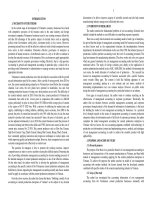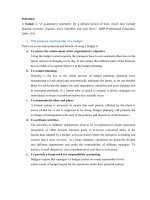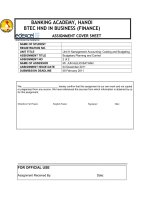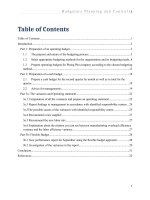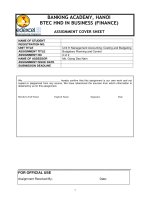Management Accounting Assignment 2
Bạn đang xem bản rút gọn của tài liệu. Xem và tải ngay bản đầy đủ của tài liệu tại đây (689.51 KB, 33 trang )
Management Accounting: Costing and Budgeting
Cost Information Analysis
Prepared for:
Lecturer, Mr. Jun Alejo Bathan
Unit 9: Management Accounting: Costing and Budgeting
Banking Academy, Hanoi
BTEC HND in Business (Finance)
Prepared by: Maple Group
Vương Thị Quỳnh Anh - Lynn
Ngô Thị Huyền Trang - Jess
Nguyễn Phương Thảo - Key
Nguyễn Thị Kiều Anh - Snow
Submitted: 14/06/201
4
TABLE OF CONTENTS
EXECUTIVE SUMMARY ....................................................................................................... 6
INTRODUCTION ..................................................................................................................... 7
TASK 1: BUDGETING ............................................................................................................. 8
Task 1a: Budgeting process................................................................................................... 8
1a.1 The purpose of the budgeting process ...................................................................... 8
1a.2 The nature of budgeting process ............................................................................... 9
1a.3 Budget of Healthful food, Inc ................................................................................. 11
1a.4 Select appropriate budgeting method for the organization and its need ................. 13
Task 1b: Prepare budgets .................................................................................................... 16
TASK 2: CASH BUDGET ...................................................................................................... 25
2.1 Definition ...................................................................................................................... 25
2.2 Prepare cash budget for Eye Care Company ................................................................. 25
TASK 3: STANDARD COSTING AND VARIANCE ANALYSIS ...................................... 27
Task 3a: Computation all the variances, prepare an operating statement for the
management and explain about the possible causes of the variances ................................. 27
3a.1 Calculation variances .............................................................................................. 27
3a. 2 Operating statement ............................................................................................... 29
3a.3 Explanation about the possible causes of the variances with identified
responsibility centres ...................................................................................................... 31
Task 3b: Preparing performance report ............................................................................... 33
3b.1 Definition ................................................................................................................ 33
3b.2 Preparation a revised performance report for Branson Manufacturing, Inc ........... 34
CONCLUSION ........................................................................................................................ 36
REFERENCES ........................................................................................................................ 36
5
EXECUTIVE SUMMARY
In this assignment we explain the purpose and nature of the budgeting process, select
appropriate budgeting methods for the organization and its need, prepare budget according to
the chosen budgeting method, prepare a case budget, calculate variances, identify possible
causes and recommend corrective action base on the outcomes in scenario was send from
teacher.
The assignment is divided into 3 main tasks based on 7 outcomes of scenario
Task 1
Outcome 3.1: Explain the purpose and nature of the budgeting process
Outcome 3.2: Select appropriate budgeting methods for the organization and its needs
Outcome 3.3: Prepare budgets according to the chosen budgeting method
Task 2
Outcome 3.4: Prepare a cash budget
Task 3
Outcome 4.1: Calculate variances identify possible causes and recommendation
corrective action
Outcome 4.2: Prepare an operating statement reconciling budgeted and actual result
Outcome 4.3: Report findings to management in accordance with identified
responsibility centers
However, because of limitations about words, this report only gives general information
about understanding costing and budget. The researcher hopes that those disadvantages will
be improved in the future. Thanks to teacher Jun Pyo and his lectures help us to complete the
assignment successfully.
6
INTRODUCTION
This assignment we are talking about costing and budgeting so we will explain the purpose
and nature of the budgeting process, select appropriate budgeting methods for the
organization and its needs, prepare budgets according to the chosen budgeting method,
calculate variances, identify possible causes and recommend corrective action, prepare an
operating statement reconciling budgeted and actual results by applying new techniques were
invented to present the accounts periodically, not necessarily at the end of the year, before the
management. From which, we can have plan to deal with budgetary and control, preparing
forecasts and budgets and then comparing them to the actual results. So we can improve our
skill, we known how to work with numbers in accounting, how to calculated costing and
budgeting.
7
TASK 1: BUDGETING
Task 1a: Budgeting process
1a.1 The purpose of the budgeting process
First of all, we need to understanding the word “budget”, according to American Heritage
Dictionary; budgeting is a critically important part of the business planning process. Business
owners and managers need to be able to predict whether a business will make a profit or not.
A budget is basically a model of how the business might perform, financially speaking, if
certain strategies, events, plans are carried out (Isaac, n.d.).
Purposes/Benefits
Explanation
To ensure the achievement To draw up as targets to be achieved within the timescale of the
of
the
organization’s budget plan.
objectives
To compel planning
Planning process: Identify objectives
To assess effectiveness of plans.
To give decision to flow the plan or not
Planning: Evaluate each strategy and Choose alternative
courses of action
To communicate ideas and To ensure that each person affected by the plans is aware of
plans
what he or she is supposed to be doing
Communication might be one-way, with managers giving
orders to subordinates, or there might be a two-way dialogue.
Control: Measure actual results and compare with the
plan. Manage subordinates, motivate them execute the
plan in order to maintain actual results same or better than
expected result.
Co-ordinate activities
To ensure maximum integration of effort towards common
goals of the activities of different departments need to be
coordinated.
Planning: Identify alternative courses of action (strategies)
which might contribute towards achieving the objects
To provides a framework for Require: managers of budget center have to control under their
responsibility accounting
personal control achieve budget target
Control: Support manage control subordinate.
8
To establish a system of To control over actual performance is provided by the
control
comparisons of actual results against the budget plan.
To investigate departures from budget
The reasons for the departures can be found and acted upon.
Control: employees who join in execution of budget
Motivate
employees
to The interest and commitment of employers can be retained if
improve their performance
there is a system which lets them know how well or badly they
are performing.
The identification of controllable reasons for departures from
budget with managers responsible provides an incentive for
improving future performance.
Control: Respond to divergences from plan
Table 1: Purpose and benefit of budgeting process
1a.2 The nature of budgeting process
Planning and control are important processes which contribute a lot to the success of a
company. Planning involves establishing a basic strategy, selecting a course of action, and
specifying how the action will be implemented. Control helps to ensure that the plan is
actually carried out and is appropriately modified as circumstances change.
The overall planning and control process is summarized in the chart follows:
9
Step 1: Identify objectives
The objective of Healthful food Inc. is increase sales by 12% per year, increase
income before tax by 15% per year, and maintain long – term debt at a maximum of
16% of assets. Budget is the most possible way to help the company achieve this
because a budget assists you in striving toward financial goals. Clearly seen the
objectives will help Healthful Foods Inc. maximize profits. Although maximizing
their profits is not always as easy as maximizing sales which lead to be successful.
From which, it can motivate their employees.
Step 2: Identify potential strategies
In this step, budget is made to set out specific targets for each strategy. Understanding
the benefits of using a potential strategy will help business owners and managers of
Healthful Foods Inc. can appreciate the value of the invested time and money into a
comprehensive plan because errors and inaccuracies will always remain since it is
impossible to predict the future. Major external events such as rising energy prices or
the global recession may distort the whole process.
Step 3: Evaluate strategies
Strategic evaluation is a way for entrepreneur to assess the ability and effective
productivity of their firm and their future endeavors. Base on terms of suitability,
feasibility and acceptability in the context of strategic analysis, the Managing Director
of Healthful Foods Inc. can evaluate and then choose the greatest potential strategies
that can help the company to achieve the objective quickly and effectively.
Step 4: Choose alternative courses of action
After evaluating clearly, it can help increase the confidence of investors so Healthful
Foods Inc. with greater access to capital, which makes it easier to grow and expand
operations. When Healthful Foods Inc. develops effective strategies, they gain a
competitive advantage over their counterparts, which means greater success in the
long run.
Step 5: Implement the long-term plan
Chosen strategies together and co-ordinate them into a long- term plan so Healthful
Foods Inc. can anticipate roadblocks, so be useful for their managers to make decision
easily, quickly and correctly. In addition, it helps investors see clearly the efficiency
of the firm so that they can know what to do and should invest or not.
10
Step 6 and 7: Measure actual results and compare with plan. Respond to divergences
from plan
Particularly, when we have long- term plan we can comparing actual results with
plans that set out so we can know how many percentage of the plan that has been
done and hence we know how much work to do so from which we can balance the
performance of the work effectively include money and human resources in the best
way. Finally, evaluating the actual results and comparison with the plan, its helps the
company realizes what the activity is inconsistent from which to set out plans to
resolve the problem and avoid wasting time and human resources
1a.3 Budget of Healthful food, Inc
a. Meet or not meet objective of company
Objective 1: Increase sales by 12% per year
Increase sales =
× 100%
=
× 100% = 11.5%
Not meet objective
Objective 2: Increase income before tax by 15% per year
Increase income before tax
=
=
× 100%
× 100% = 15%
Meet objective
Objective 3: Maintain long – term debt at a maximum of 16% of assets
Percentage of long – term debt =
× 100%
=
× 100% = 15%
Meet objective
11
Objective 4: Maintaining cost of goods sold at maximum of 70% of sales
Maintaining cost of goods sold =
× 100%
=
× 100% = 60.64%
Meet objective
With this budget, company meet 3 objective and 1 objective is nearly with the number
that company gave for accountant (the objective of company is 12% increase sales and
according to budget, sales increase 11.5% when compared with sales value of previous
year). In summary, this budget is seem to meet all the objective of company in year
20x2.
b. The influence of behavior of John Winslow – cost accountant of Healthful Foods Inc
To have a budget that can meet the objective of company, Wilson did two activities and it
make slack in accounting.
First, he overestimates the ending inventory. This activity can make increase the ending
inventory of company from that, make decrease cost of goods sold as a result, it make
increase income before tax of company.This activity gives wrong information for director
of company and makes a gap in accounting system of company. As a result, Director
cannot see the right problem that company have and hardly give right solution to deal it.
Second, he move reclassify fruit and gain inspection cost from manufacturing cost to
administrative cost. His activity make decrease manufacturing cost so can make decrease
inventory and cost of goods sold of company. It influences income of company and make
manager of company do not have right information about the actual situation of company
because of that company’ manager cannot find solution to help company deal its problem.
12
1a.4 Select appropriate budgeting method for the organization and its need
a. Fixed and flexible method
Advantage
Disadvantage
- Allowing a business to measure - Preparing fixed budgets based on
both
short-term
and
long-term one activity level may not give an
budgets
Fixed budget
indication of what may happen if
- Allocating a set amount of money actual sales and production do differ
towards essentials such as overhead from expected levels.
cost
- Fixed budgets will often fail to
- Making profit measurement easier, provide a realistic target against
since you allocate the same amount which performance can be judged.
of money toward necessities on a Certain costs
production.
regular basis (Miriam, n.d.)
will
vary
with
- Improved performance evaluation, - Not allowing the manager to insert
this allows the company to evaluate set figures, prediction is difficult
the manager performance more fairly - Too many variables, when one
Flexible
budget
- Useful variance analysis, a flexible variable in a flexible budget is
budget considers cost increases due subject to change, other variables in
to
increased
activity
levels, the budget can also change, too.
eliminating the impact.
-
Complicated
because
flexible
budget require the prepares to insert
a range of estimates.
Table 2: Comparison between fixed and flexible method
13
b. Top-down (imposed) budget VS Bottom-up (participated) budget
Advantages
Disadvantage
- They improve the co-ordination - Budgets can be inaccurate and not
between the plans and objectives of conflict with the objectives of the
divisions.
lower departments because only top
- When a staff is given a certain managers prepare the budgets.
Top-down
budget
budget to work with, it must make - Managers and employees may be
prudent financial decisions about resentful that their input is not
how the money will be used. valued in the budgeting process.
(McQuerrey, n.d.)
(McQuerrey, n.d.)
- Can be quite accurate for individual - Lead those who are in charge of
tasks. As long as no tasks have been tasks and also project managers to
forgotten, then this can work quite ask for more funding than will
well.
actually be needed.
- Bottom-up budgeting involves all - Lacking knowledge may make
Bottom-up
budget
members of a particular project, budget
unachievable
or
cannot
which can be a benefit in terms of connect with opinion of director
organization
morale
and - Budget of each department may be
involvement.
not has relationship.
- Senior’s manager’s overview of the - Time consuming: Lack of skill
business can be combined with also knowledge (Arthur, n.d.)
operational
level
of
details
to
produce better budgets (Arthur, n.d.)
Table 3: Comparison between top – down budget and bottom – up budget
14
c. Incremental and zero based budgeting system
Advantages
Incremental
budgeting
Disadvantages
- The budget operates under a stable
- No incentive for developing
and predictable system and any change
new ideas.
will be gradual.
- No incentives to reduce costs.
- The impact of change can be seen
- Encourages spending up to the
quickly.
budget so that the budget is
- Managers can operate their
maintained next year.
departments on a consistent basis.
- The budget may become out of
- The system is simple to operate and
date and no longer relate to the
easy to understand.
level of activity or type of work
- Conflicts should be avoided if
being carried out.
departments can be seen to be treated.
- Allocation of resources linked to - It a complex time consuming
results and needs.
process
- Develops a questioning attitude.
- Short term benefits may be
- Wastage and budget slack should be
emphasized to the detriment of
long term planning
Zero based
eliminated.
budgeting
- Prevents creeping budgets based on - Affected by internal politics previous year’s figures with an added can result in annual conflicts over
budget allocation.
on percentage.
- Encourages managers to look for
alternatives (tutor2u, 2012).
Table 4: Comparison between Incremental and zero based budgeting system
15
Task 1b: Prepare budgets
1. Sales budget
Truong Hai Tire Company
Sales Budget
For the year 2013
Passenger
Budgeted sales in units
Total
116,400
27,000
65
200
7,566,000
5,400,000
Selling price per unit
Budgeted sales in dollars
Truck
12,966,000
Budgeted sales in dollars = Budgeted sales in units × Selling price per unit
Passenger = 116,400 x 65 = $7,566,000
Truck = 27,000 x 200 = $5,400,000
2. Production budget
Truong Hai Tire Company
Production Budget
For the year 2013
Passenger
Budgeted sales in units
Truck
116,400
27,000
6,590
2,360
122,990
29,360
5,000
2,000
117,990
27,360
92
96
Gross production in Finishing Department
128,250
28,500
Good production required in Molding Department
128,250
28,500
95
95
135,000
30,000
Desired ending finished good
Total units required
Less: Beginning Finished good
Good production required in Finishing Department
Good yield in Finishing Department (%)
Good yield in Molding Department (%)
Gross production in Molding department
Total unit required = Budgeted sales in units + Desired ending finished good
= 116,400 + 6,590 = 122,990
Good production required in Finishing Department = Total units required – Beginning FG
16
Passenger = 122,990 – 5,000 = 117,990
Truck = 29,360 – 2,000 = 27,360
According to scenario, the reject rate arising from an inspection at the end of each department
is:
Molding Department
Passenger is 5% so Good yield in Molding Department is 95%
Truck is 5% so Good yield in Molding Department is 95%
Finishing Department
Passenger is 8% so Good yield in Finishing Department is 92%
Truck is 4% so Good yield in Finishing Department is 96%
Gross production in Finishing Department =
Passenger: =
Truck: =
× 100%
x 100 = 128,250
x 100 = 28,500
Gross production in Molding Department =
Passenger: =
Truck: =
× 100%
x 100 = 135,000
x 100 = 30,000
17
3. Direct materials budget
Truong Hai Tire Company
Direct Materials Budget
For the year 2013
Passenger
Truck
Total
STEEL BELTS
Gross production required in units
Direct materials required per unit, in pounds
Total direct materials required, in pounds
135,000
30,000
1.5
4
202,500
120,000
322,500
Less: Beginning direct material in inventory
7,000
Plus: Desired ending direct materials in inventory
6,000
Direct materials to be purchased, in pounds
321,500
Budgeted direct materials cost per pounds
3
964,500
Budgeted cost of direct materials
RUBBER
Gross production required in units
Direct materials required per unit, in pounds
Total direct materials required, in pounds
135,000
30,000
10
30
1,350,000
900,000
2,250,000
Less: Beginning direct material in inventory
75,000
Plus: Desired ending direct materials in inventory
60,000
Direct materials to be purchased, in pounds
2,235,000
Budgeted direct materials cost per pounds
2
Budgeted cost of direct materials
4,470,000
Total cost of direct materials to be purchased
5,434,500
Steel belts
Total direct materials required, in pounds = Gross production required in units x Direct
materials required per unit, in pounds
Passenger: = 135,000 x 1.5 = 202,500
Truck = 30,000 x 4 = 120,000
Direct materials to be purchased, in pounds = Total direct materials required, in pounds Beginning direct material in inventory + Desired ending direct materials in inventory
= 322,500 – 7,000 + 6,000 = 321,500
18
Budgeted cost of direct materials = Direct materials to be purchased, in pounds x Budgeted
direct materials cost per pounds
= 321,500 × 3 = $964,500
Rubber
Total direct materials required, in pounds = Gross production required in units × Direct
materials required per unit, in pounds
Passenger: = 135,000 × 10 = 1,350,000
Truck = 30,000 × 30 = 900,000
Direct materials to be purchased, in pounds = Total direct materials required, in pounds Beginning direct material in inventory + Desired ending direct materials in inventory
= 2,250,000 – 75,000 + 60,000 = 2,235,000
Budgeted cost of direct materials = Direct materials to be purchased, in pounds x Budgeted
direct materials cost per pounds
=2,235,000 × 2 = $4,470,000
19
4. Direct labor cost budget
Truong Hai Tire Company
Direct Labor Cost Budget
For the year 2013
Passenger
Truck
Total
Molding Department
Gross production required, in units
Direct labor required per unit, in hours
Total direct labor hours required
Budgeted cost per direct labor hour
Budgeted Direct labor in Molding Department
135,000
30,000
0.1
0.25
13,500
7,500
15
15
202,500
112,500
128,250
28,500
0.05
0.15
6,412.5
4,275
13
13
83,362.5
55,575
138,937.5
285,862.5
168,075
453,937.5
315,000
Finishing Department
Gross production required, in units
Direct labor required per unit, in hours
Total direct labor hours required
Budgeted cost per direct labor hour
Budgeted Direct labor in Finishing Department
Total budgeted direct labor cost
Total direct labor hours required = Gross production required, in units x Direct labor required
per unit, in hours
Budgeted Direct labor in Department = Total direct labor hours required x Budgeted cost per
direct labor hour
Molding Department
Total direct labor hours required:
Passenger = 135,000 x 0.1 = 13,500
Truck = 30,000 x 0.25 = 7,500
Budgeted direct labor in Molding Department:
Passenger = 13,500 x 15 = $202,500
Truck = 7,500 x 15 = $112,500
Finishing Department
Total direct labor hours required:
20
Passenger = 128,250 x 0.05 = 6,412.5
Truck = 28,500 x 0.15 = 4,275
Budgeted direct labor in Finishing Department:
Passenger = 6,412.5 x 13 = $83,362.5
Truck = 4,275 x 13 = $55,575
5. Manufacturing budget
Total budgeted manufacturing budget = $692,100
Total direct labor hours = 13,500 + 7,500 + 6412.5 + 4275 = 31,687.5
OVH per hour =
= 21.8
Truong Hai Tire Company
Manufacturing budget
For the year 2013
Passenger
Truck
Molding Department
Total direct labor hours required
Overhead per direct labor hour
Overhead absorpted
13,500
7,500
21.8
21.8
294,300
163,500
6,412.5
4,275
21.8
21.8
139,792.5
93,195
434,092.5
256,695
Finishing Department
Total direct labor hours required
Overhead per direct labor hour
Overhead absorpted
Total Overhead absorpted
Overhead absorpted = Total direct labor hours required × Overhead per direct labor hour
Molding Department
Passenger = 13,500 x 21.8 = $294,300
Truck = 7,500 x 21.8 = $163,500
Finishing Department
Passenger = 6,412.5 x 21.8 =$139,792.5
Truck = 4,275 x 21.8 =$93,195
21
6. Ending inventory budget for finished goods
Truong Hai Tire Company
Ending Inventory Budget For Finished Good
For the year 2013
Passenger
Truck
Total
Budgeted cost of direct materials to be used
Steel belts
607,500
360,000
2,700,000
1,800,000
Budgeted Direct labor cost
285,862.5
168,075
Budget manufacturing overhead
434,092.5
256,695
Total budgeted manufacturing cost
4,027,455
2,584,770
Good production in unit
117,990
27,360
Budgeted cost per unit
34.1
94.5
6,590
2,360
224,719
223,020
Rubber
Budgeted ending Finished goods, in unit
Budgeted cost of ending Finished goods
6,612,225
447,739
Budgeted cost per unit =
Passenger =
Truck =
= $34.1
= $94.5
Budgeted cost of ending Finished goods = Budgeted cost per unit × Budgeted ending
Finished goods, in unit
Passenger = 34.1 x 6,590 = $224,719
Truck = 94.5 x 2,360 = $223,020
22
7. Budget cost of goods sold
Truong Hai Tire Company
Cost Of Goods Sold Budget
For the year 2013
Beginning Finished goods inventory
Total budgeted manufacturing cost
Cost of good available for sale
Less: Budgeted ending Finished goods inventory
Budgeted cost of goods sold
Passenger
175,000
Truck
240,000
Total
415,000
6,612,225
7,027,225
447,739
6,579,486
Beginning FG inventory = Beginning inventory × Cost per unit
Passenger = 2,000 × 120 = $240,000
Truck = 5,000 × 35 = $175,000
Cost of good available for sale = Beginning Finished good inventory + Total budgeted
manufacturing cost
= 415,000 + 6,612,225 = $7,027,225
Budget cost of goods sold = Cost available for sales - Budgeted ending Finished goods
inventory
= 7,027,225– 447,739 = $6,579,486
23
8. Budget income statement
Truong Hai Tire Company
Budget Income Statement
For the year 2013
$
Sales
12,966,000
Cost of goods sold
6,579,486
Gross profit
6,386,514
Operating cost
Advertising expense
942,000
Office rent expense
123,000
Office salaries expense
821,000
Office supplies expense
45,500
Officers' salaries expense
661,000
Sales salaries expense
868,000
Telephone and fax expense
Travel expense
33,500
443,000
Total operating cost
3,937,000
Net income
2,449,514
Gross profit = Sales – Cost of goods sold = 12,966,000 - 6,579,486 = $6,386,514
Net income = Gross profit – Operating cost = 6,386,514 - 3,937,000 = $2,449,514
24
TASK 2: CASH BUDGET
2.1 Definition
Cash budget is the financial plan that is a summary of estimated receipts (cash inflows) and
payments (cash outflows) over a stated period. Two common methods of cash-budgeting are
adjusted
net
income
approach
and
Cash
receipts
and
disbursements
approach
(BusinessDictinary, n.d.)
2.2 Prepare cash budget for Eye Care Company
a. Cash budget of Eye Care Company
Eye Care Company
CASH BUDGET
For the third quarter of 20XX
July ($)
August ($)
September ($)
3rd quarter ($)
342,000
369,000
964,500
RECEIPTS
Sales
253,500
May
10,000
10,000
June
156,000
12,000
July
87,500
227,500
17,500
332,500
102,500
266,500
369,000
85,000
85,000
August
September
Loan
168,000
30,000
30,000
283,500
342,000
369,000
994,500
157,500
210,000
246,000
613,500
Salaries and wages
29,000
30,000
30,000
89,000
Advertising
78,000
91,000
67,000
236,000
7,000
7,000
7,000
21,000
PAYMENT
Merchandise purchase
Rent payment
Equipment purchase
47,000
47,000
Interest
Loan payment
900
900
30,000
30,000
318,500
338,000
380,900
1,037,400
Surplus/ Deficit
-35,000
4,000
-11,900
-42,900
Opening balance
46,000
11,000
15,000
46,000
Closing balance
11,000
15,000
3,100
3,100
25
Sales
According to scenario, 25% of a month’s sales are collected in the month of sale, 65% in the
month following sale, and 5% in the second month following sale. As a result, the sales that
company will receipt in July, August and September as follow:
In July:
5% sales in May = 200,000 × 5% = $10,000
65% sales in June = 240,000 × 65% = $156,000
25% sales in July = 350,000 × 25% = $87,500
Total sales that receipt in July = 10,000 + 156,000 + 87,500 = $253,500
In August:
5% sales in June = 240,000 × 5% = $12,000
65% sales in July = 350,000 × 65% = $227,500
25% sales in August = 410,000 × 25% = $102,500
Total sales that receipt in July = 12,000 + 227,500 + 102,500 = $342,000
In September:
5% sales in July = 350,000 x 5% = $17,500
65% sales in August = 410,000 x 65% = $166,500
25% sales in September = 340,000 x 25% = $85,000
Total sales that receipt in July = 17,500 + 166,500 + 85,000 = $369,000
Merchandise purchases
Merchandise purchases are paid in full during the month following purchase so:
In July, company has to pay merchandise purchases in June: $157,500
In August, company has to pay merchandise purchases in July: $210,000
In September, company has to pay merchandise purchases in August: $246,000
b. The plan repaid loan
If company need a minimum cash balance of $10,000 to start each month, company can pay
loan as planned (pay $30,000 in September). Instead of that, company can pay 50% of loan in
September and 50% in after months. This activity can ensure the minimum such balance of
$10,000 to start each month for Eye Care Company.
26
TASK 3: STANDARD COSTING AND VARIANCE ANALYSIS
Task 3a: Computation all the variances, prepare an operating statement for the
management and explain about the possible causes of the variances
3a.1 Calculation variances
a. Material variance
According to scenario:
Standard cost: Direct material (1 petrie dish @ $2 per dish): $2.00
Standard price (SP) = $2.00
Standard quantity (SQ) = 2,500
Actual cost: Direct materials (2,530 dishes): $5,313
Actual quantity (AQ) = 2,530
Actual price (AP) =
= 2.1
Material price variance
(AQ × AP)
(2,530 × 2.1)
$5,313
-
(AQ × SP)
(2,530 × $2.00)
$5,060
=
$253 (A)
=
$60 (A)
Material price variance = $253 (U)
Material quantity variance
(AQ × SP)
(2,530 ×
$2.00)
$5,060
Material quantity variance = $60 (U)
(SQ × SP)
(2,500 × $2.00)
$5,000
Material variance = Material price variance + Material quantity variance
= $253 + $60 = $313 (U)
b. Labor Variance
According to scenario
Standard cost: Direct labor (0,5 hours @ $20 per hour) : 10.00
Standard rate (SR) = $20
Standard hour (SH) = 2,500 × 0.5 = 1,250
Actual cost: Direct labor (1,240 hours): 26,040
Actual hour (AH) = 1,240
Actual rate (AR) =
= 2.1
27
Labor price variance
(AH × AR)
(1,240 × $21)
$26,040
-
(AH × SR)
(1,240 × $20)
$24,800
= $1,240 (A)
(SH × SR)
(1,250 × $20)
$250,00
= $200 (F)
Labor price variance = $1,240 (U)
Labor quantity variance
(AH × SR)
(1,240 × $20)
$24,800
-
Labor quantity variance = $200 (F)
Labor variance = Labor price variance + Labor quantity variance
= 1240 - 200 = 1,040 (A)
c. Variable manufacturing overhead
According to scenario:
Standard cost: Variable overhead (0.5 hours @ $8 per hours): 4.00
Budgeted overhead rate (SP) = 8
Standard quantity (SQ) = 2,500 × 0.5 = 1,250
Actual cost: Variable overhead: 10,100
Actual overhead rate (AP) =
Actual quantity (AQ) = 1,240
Spending variance (PV)
AQ
×
1,240
×
(AP - SP)
(
- 8)
1,240
= 180 (A)
Spending variance = 180 (A)
Efficiency variance (EV)
SP
8
8
×
×
(AQ - SQ)
(1,240 - 1,250)
10
Efficiency variance = 80 (F)
28
= 80 (F)

